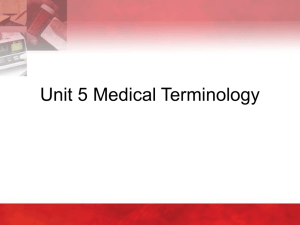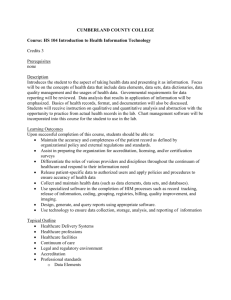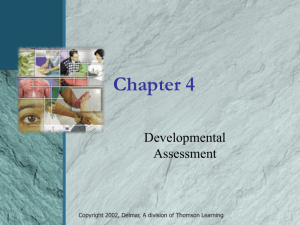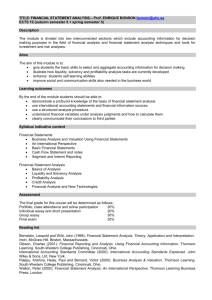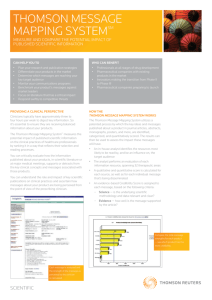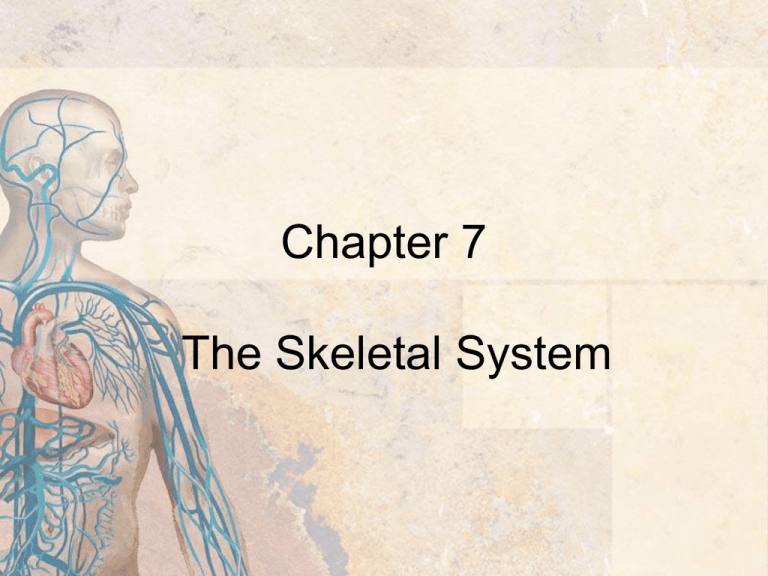
Chapter 7
The Skeletal System
Introduction
• Skeleton - supporting structure
• Bones and associated cartilage, tendons
and ligaments
• Works with muscles for movement
• Mineral salts form the inorganic matrix of
bone
• Leonardo da Vinci - first correct
illustrations of all bones
©2006 by Thomson Delmar Learning, a part of the Thomson
Corporation. ALL RIGHTS RESERVED.
2
The Functions of the Skeletal
System
•
•
•
•
•
Support surrounding tissues
Protect vital organs and soft tissues
Provide levers for muscles to pull on
Manufacture blood cells
Store mineral salts
©2006 by Thomson Delmar Learning, a part of the Thomson
Corporation. ALL RIGHTS RESERVED.
3
The Growth and Formation of
Bone
General Information
• A three-month fetal skeleton completely
formed (cartilage)
• Ossification and growth begin
• Longitudinal growth continues until
– 15 years of age - girls
– 16 years of age - boys
• Bone maturation until 21 years of age
©2006 by Thomson Delmar Learning, a part of the Thomson
Corporation. ALL RIGHTS RESERVED.
5
Deposition of the Bone
• Osteoblasts - embryonic bone cells
• Osteocytes - mature osteoblasts
• Strain on bone (exercise) increases
bone strength
• Osteoclasts - bone reabsorption and
remodeling
©2006 by Thomson Delmar Learning, a part of the Thomson
Corporation. ALL RIGHTS RESERVED.
6
Types of Ossification
• Intramembranous
– dense connective membranes replaced by
calcium salts
– cranial bones
• Endochondral
– bone develops inside cartilage environment
– all other bones of the body
©2006 by Thomson Delmar Learning, a part of the Thomson
Corporation. ALL RIGHTS RESERVED.
7
Maintaining the Bone
• Endocrine system control
– calcium storage
– blood calcium levels
– excretion of excess calcium
• Parathormone - calcium release
• Calcitonin - calcium storage
©2006 by Thomson Delmar Learning, a part of the Thomson
Corporation. ALL RIGHTS RESERVED.
8
The Histology of Bone
The Haversian System of Compact
Bone
• Clopton Havers - histology of compact
bone
• Haversian canals - run parallel to surface
– surrounded by concentric rings of bone
– lacunae: cavity containing osteocyte
– lacunae connected by canaliculi
©2006 by Thomson Delmar Learning, a part of the Thomson
Corporation. ALL RIGHTS RESERVED.
10
Cancellous Bone
• Trabeculae - meshwork of bone
• Spongy appearance created by trabeculae
• Bone marrow fills spaces between
trabeculae
©2006 by Thomson Delmar Learning, a part of the Thomson
Corporation. ALL RIGHTS RESERVED.
11
Bone Marrow
• Red marrow
– hematopoiesis
– ribs, sternum, vertebrae, pelvis
• Yellow marrow
– fat storage
– shafts of long bones
©2006 by Thomson Delmar Learning, a part of the Thomson
Corporation. ALL RIGHTS RESERVED.
12
The Classification of Bones
•
•
•
•
•
Long
Short
Flat
Irregular
Sesamoid
©2006 by Thomson Delmar Learning, a part of the Thomson
Corporation. ALL RIGHTS RESERVED.
13
Bone Markings
• Processes - projections from the surface
– spine, condyle, tubercle, trochlea, trochanter,
crest, line, head, neck
• Fossae - depressions
– suture, foramen, meatus, sinus, sulcus
• Functions - muscle attachment,
articulation, passageways
©2006 by Thomson Delmar Learning, a part of the Thomson
Corporation. ALL RIGHTS RESERVED.
14
Divisions of the Skeleton
The Axial Skeleton
Cranial Bones
•
•
•
•
•
•
•
Frontal bone (1)
Parietal bones (2)
Occipital bone (1)
Temporal bone (2)
Sphenoid bone (1)
Ethmoid bone (1)
Auditory ossicles (6)
©2006 by Thomson Delmar Learning, a part of the Thomson
Corporation. ALL RIGHTS RESERVED.
17
Facial Bones
•
•
•
•
•
•
•
•
Nasal bones (2)
Palatine bones (2)
Maxillary bones (2)
Zygomatic bones (2)
Lacrimal bones (2)
Nasal conchae (2)
Vomer bone (1)
Mandible (1)
©2006 by Thomson Delmar Learning, a part of the Thomson
Corporation. ALL RIGHTS RESERVED.
18
The Orbits, Nasal Cavities, and
Foramina
• Orbits - cavities enclose and protect the
eyes
• Nose framework surrounds the two nasal
cavities
• Foramina
– passageways for blood vessels and nerves
– foramen magnum - spinal cord passage
©2006 by Thomson Delmar Learning, a part of the Thomson
Corporation. ALL RIGHTS RESERVED.
19
The Hyoid Bone
• No articulation with other bones
• Suspended by ligaments from styloid
process
• Supports the tongue
©2006 by Thomson Delmar Learning, a part of the Thomson
Corporation. ALL RIGHTS RESERVED.
20
The Torso or Trunk
• Sternum
• Ribs - 12 pairs
– true ribs, false ribs, floating ribs
©2006 by Thomson Delmar Learning, a part of the Thomson
Corporation. ALL RIGHTS RESERVED.
21
The Torso or Trunk
• Vertebrae
– seven cervical
– twelve thoracic
– five lumbar
– sacrum
– coccyx
©2006 by Thomson Delmar Learning, a part of the Thomson
Corporation. ALL RIGHTS RESERVED.
22
The Appendicular Skeleton
The Bones of the Upper
Extremities
• Shoulder Girdle - clavicle and scapula
• Arm
– upper arm - humerus
– forearm - ulna and radius
– wrist - carpals
– hand - metacarpals (5/hand)
– fingers - phalanges (14/hand)
©2006 by Thomson Delmar Learning, a part of the Thomson
Corporation. ALL RIGHTS RESERVED.
24
The Bones of the Lower
Extremities
• Pelvic Girdle – ischium, ilium, pubis
• Leg
– upper leg - femur
– lower leg - patella, tibia, fibula
– foot
• tarsals
• metatarsals (5/foot)
• phalanges (14/foot)
©2006 by Thomson Delmar Learning, a part of the Thomson
Corporation. ALL RIGHTS RESERVED.
25
The Arches of the Foot
•
•
•
•
Medial longitudinal - highest
Lateral longitudinal
Transverse
Pes planus - flat foot
©2006 by Thomson Delmar Learning, a part of the Thomson
Corporation. ALL RIGHTS RESERVED.
26
Animation
• The following animation illustrates the
damage that can occur to muscle, bone, or
joint due to a twisting action.
©2006 by Thomson Delmar Learning, a part of the Thomson
Corporation. ALL RIGHTS RESERVED.
27
Animation
• The following animation illustrates a
fracture due to direct force to the bone
from another object.
©2006 by Thomson Delmar Learning, a part of the Thomson
Corporation. ALL RIGHTS RESERVED.
28

